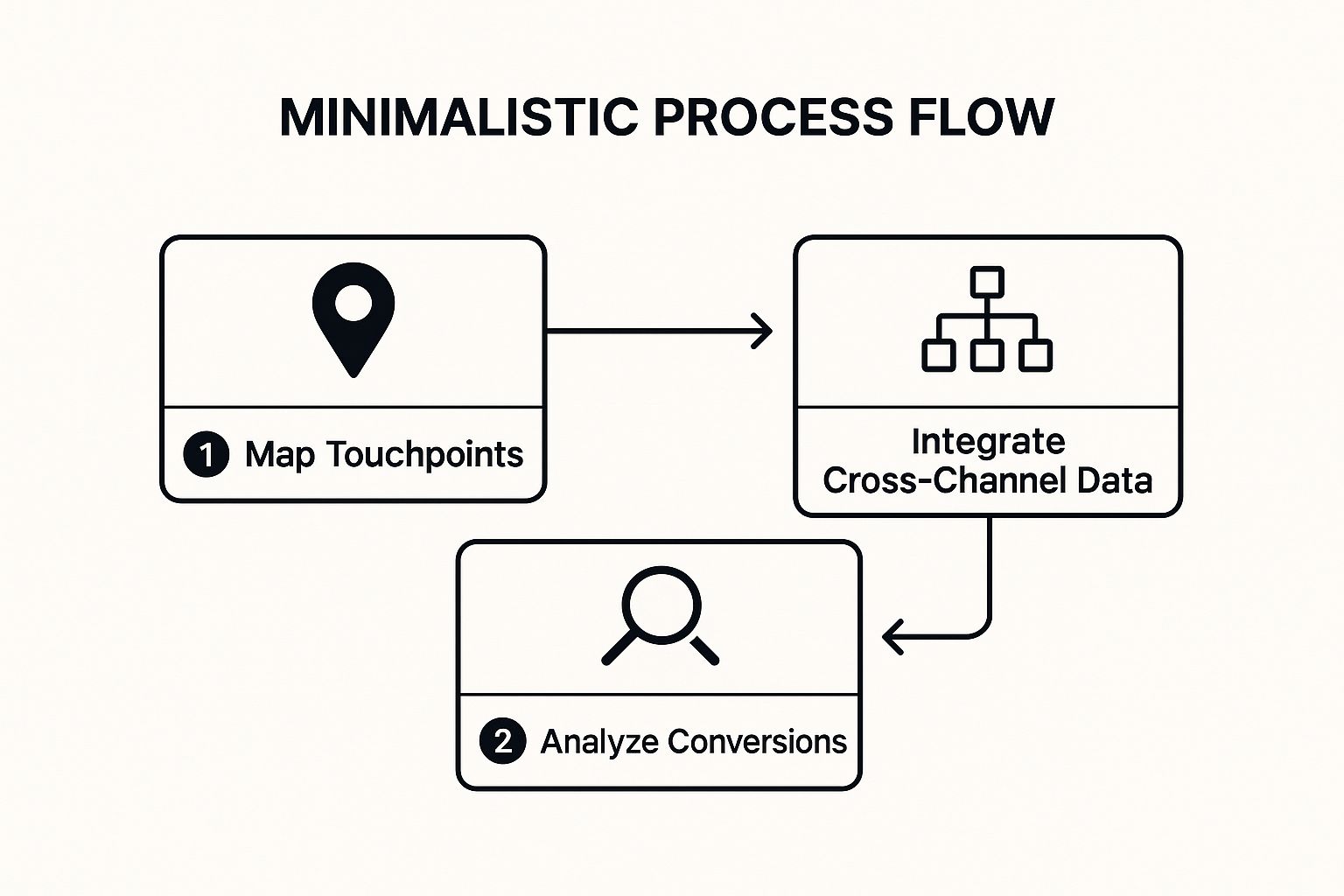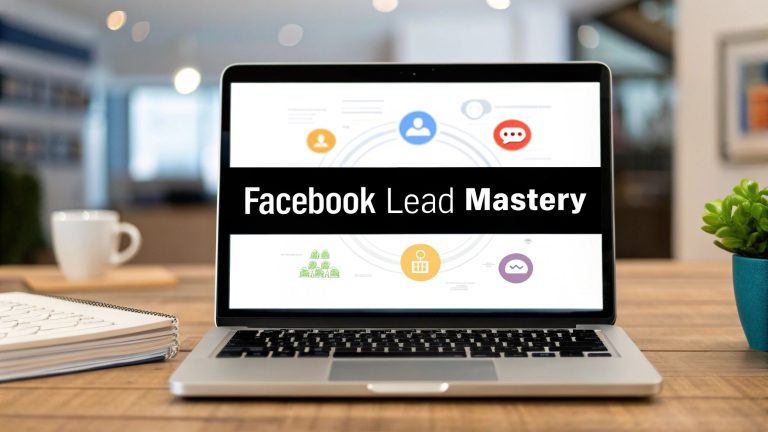7 Proven Strategies to Improve Marketing ROI in 2025
Beyond Clicks and Impressions: A Strategic Roadmap to Real ROI
In a competitive market, tracking superficial metrics like clicks and impressions is a path to wasted ad spend. True marketing success is measured by its return on investment (ROI), the tangible revenue and profit generated from every dollar spent. Many businesses struggle to connect their marketing activities to bottom-line results, pouring budgets into channels without a clear understanding of their true impact. This article cuts through the noise. We will provide a comprehensive roadmap with seven advanced, actionable strategies designed to help you improve marketing ROI.
This is not a list of generic tips. Instead, you will find a detailed breakdown of sophisticated but achievable tactics that deliver measurable outcomes. We will explore how to:
- Optimize for long-term customer value, not just initial sales.
- Implement precise attribution models to understand your entire customer journey.
- Automate lead nurturing to convert prospects more efficiently.
- Use advanced segmentation for hyper-targeted campaigns.
- Rethink your budget allocation with proven modeling techniques.
These proven methods will empower you to make data-driven decisions, maximize budget efficiency, and transform your marketing from a cost center into a powerful revenue engine. We will also illustrate how tools like LeadSavvy Pro can streamline critical parts of this process, from instant lead alerts for Facebook Ads to seamless CRM integration, ensuring you capitalize on every opportunity and convert valuable leads faster and more effectively. Let's dive into the strategies that will redefine how you measure marketing success.
1. Strategy 1: Master Customer Lifetime Value (CLV) Optimization
A truly effective strategy to improve marketing ROI requires a shift in perspective, moving beyond the immediate gratification of a first-time sale to embrace long-term customer profitability. This is the core of Customer Lifetime Value (CLV) optimization. Instead of focusing solely on minimizing initial acquisition costs, this approach prioritizes attracting and retaining customers who will deliver the most value over their entire relationship with your brand. By understanding what makes your best customers tick, you can build a resilient and sustainable growth engine fueled by loyalty.

The fundamental principle is that not all customers are created equal in terms of profitability. Some make a single, small purchase, while others become brand advocates who buy repeatedly and refer others. Mastering CLV means you can confidently invest more to acquire customers with a high potential for long-term value, knowing the upfront cost will be recouped many times over. This creates a powerful cycle where enhanced retention directly funds more effective acquisition. This focus on value also complements efforts to lower initial expenses; for a deeper dive into this, you can explore proven ways to reduce customer acquisition cost on leadsavvy.pro.
How to Implement CLV Optimization
Implementing a CLV-focused strategy involves a data-driven approach to understanding and influencing customer behavior.
- Segment Your Customer Base: Don't treat all customers the same. Use your data to group them based on CLV metrics like purchase frequency, average order value (AOV), and engagement level. A common method is RFM analysis (Recency, Frequency, Monetary). LeadSavvy Pro users can tag leads based on initial interaction or form submission data, creating the foundation for future segmentation as these leads convert to customers.
- Develop Targeted Retention Campaigns: Once segmented, create specific campaigns for each group. High-value customers might receive exclusive access to new products or personalized thank-you notes. At-risk customers, identified through predictive analytics showing a drop-off in engagement, could receive a special re-engagement offer.
- Invest in Customer Service Excellence: A primary driver of churn is poor customer service. Investing in training, tools, and processes to create positive support interactions is a direct investment in your CLV. Quick, empathetic, and effective problem resolution turns potentially negative experiences into loyalty-building moments.
Real-World Examples of High CLV
Giants like Amazon and Starbucks have built empires on this principle. Amazon's Prime membership is a masterclass in CLV, encouraging higher purchase frequency and deeper brand integration. Similarly, the Starbucks Rewards program, which drives a significant portion of its revenue, uses personalization and gamification to keep its most loyal customers engaged and spending more.
2. Attribution Modeling and Multi-Touch Attribution
To truly improve marketing ROI, you must understand which of your efforts are actually driving results. This is where attribution modeling becomes essential. It’s the practice of tracking and analyzing every customer touchpoint across their entire buying journey, moving beyond the simplistic and often misleading "last-click" model. By giving credit to each channel that influenced a conversion, you gain a holistic view of your marketing ecosystem, allowing for smarter budget allocation and a significant boost in overall effectiveness.
This strategy fundamentally changes how you perceive campaign success. Instead of attributing a sale solely to the final ad a customer clicked, you recognize the contributions of the initial blog post they read, the social media ad they saw, and the email newsletter that kept them engaged. This comprehensive understanding empowers you to invest in channels that play crucial roles earlier in the funnel, which are often undervalued by simpler attribution methods.
How to Implement Multi-Touch Attribution
Deploying a multi-touch attribution model requires a systematic approach to data collection and analysis. It's about connecting the dots across your entire marketing landscape.
- Ensure Consistent Cross-Channel Tracking: The foundation of accurate attribution is clean, consistent data. Use a standardized system like UTM parameters for all your campaign links across email, social media, paid ads, and content. This ensures every touchpoint is correctly tagged and fed into your analytics platform.
- Start with Simpler Models: Don't jump straight into complex, custom-built attribution models. Begin with standard models available in platforms like Google Analytics, such as Linear, Time-Decay, or Position-Based. Test these to see which one best reflects your typical customer journey before considering more advanced U-shaped or W-shaped models.
- Regularly Audit and Clean Your Data: Data hygiene is non-negotiable. Periodically audit your analytics to identify and fix issues like misconfigured tracking, broken UTMs, or data from internal traffic. Inaccurate data leads to flawed insights and poor budget decisions.
The following infographic outlines the core process flow for setting up a functional attribution system.

This process highlights the essential sequence: first mapping all potential customer interactions, then integrating the data from these disparate sources, and finally analyzing the unified data to assign conversion credit accurately.
Real-World Examples of Advanced Attribution
Leading analytics and CRM platforms have proven the value of this approach. Google's attribution tools have helped advertisers identify up to 20% more conversions by moving beyond last-click. Similarly, clients using Adobe Analytics' multi-touch attribution features have reported ROI improvements of 15-30%. For B2B companies, platforms like Salesforce Pardot offer robust attribution reports that connect marketing campaigns directly to sales pipeline, enabling precise optimization of B2B marketing spend.
For a visual explanation of how different attribution models work, the video below provides an excellent overview.
3. Marketing Automation and Lead Nurturing
To dramatically improve marketing ROI, you must move beyond manual, one-off campaign efforts and embrace scalable, personalized communication. This is where marketing automation and lead nurturing excel. This strategy uses software to automate repetitive marketing actions like email sends, social media posts, and ad campaign management. More importantly, it enables you to deliver targeted, relevant messages to prospects at every stage of their journey, building relationships and guiding them toward a purchase decision without constant manual intervention.

The core principle is efficiency and personalization at scale. Instead of broadcasting generic messages to your entire list, automation allows you to nurture leads based on their specific behaviors and interests. When a prospect downloads an ebook, they can be automatically entered into a sequence of emails related to that topic. This timely and relevant follow-up significantly increases engagement and conversion rates, ensuring that your marketing spend generates more qualified, sales-ready leads. For an in-depth guide on setting up these systems, you can explore the benefits of automated lead nurturing on leadsavvy.pro.
How to Implement Marketing Automation
Successfully implementing automation requires a strategic plan before ever launching a workflow. It's about sending the right message to the right person at the right time.
- Map Your Customer Journey: Before building any automation, meticulously map out the typical path a customer takes from initial awareness to purchase. Identify key touchpoints and decision-making moments where targeted communication can make the biggest impact. This map becomes the blueprint for your workflows.
- Segment Your Audience: Effective nurturing relies on relevance. Segment your leads based on demographics, behavior (e.g., pages visited, content downloaded), or their stage in the sales funnel. LeadSavvy Pro allows you to tag leads from different ad campaigns, enabling you to create highly specific nurturing sequences for each audience segment.
- Implement Lead Scoring: Set up a lead scoring system to prioritize your follow-up efforts. Assign points to leads based on actions that indicate high purchase intent, such as visiting a pricing page or requesting a demo. This allows your sales team to focus on the most valuable opportunities, boosting efficiency.
- Continuously A/B Test and Optimize: Don't set and forget your automations. Regularly test different elements like email subject lines, content, call-to-actions, and send times. Analyze performance data to identify what resonates most with your audience and continually refine your workflows for better results.
Real-World Examples of Automation ROI
The impact of automation is well-documented across industries. HubSpot, a pioneer in this space, has shown that effective lead nurturing can generate 50% more sales-ready leads at a 33% lower cost. Similarly, companies using Marketo's automation platform often see a significant improvement in their sales pipeline quality. Even on a smaller scale, Mailchimp's automation features have helped businesses achieve dramatically higher click-through rates on their campaigns compared to standard email blasts, proving that personalized, automated follow-up is a powerful driver of marketing ROI.
4. Performance-Based Marketing and Pay-Per-Performance Models
To significantly improve marketing ROI, you can de-risk your investments by tying marketing spend directly to measurable business outcomes. This is the foundation of performance-based marketing, a model where payment is contingent upon specific, pre-defined actions like a completed sale, a qualified lead, or a new customer conversion. Instead of paying for impressions or clicks, which don't guarantee tangible results, this strategy ensures that your budget is allocated only to activities proven to drive value for your business.
This approach fundamentally shifts the financial risk from the advertiser to the publisher or marketing partner. It creates a powerful incentive for partners to deliver high-quality traffic and genuine conversions, as their compensation is directly linked to their success. For businesses, especially those with tight budgets, this model offers a predictable and highly efficient way to acquire customers. It ensures that every dollar spent contributes directly to the bottom line, making it one of the most direct ways to boost marketing efficiency and profitability.
How to Implement Performance-Based Marketing
Launching a successful performance-based marketing program requires clear definitions, robust tracking, and strong partner relationships.
- Clearly Define Performance Metrics and Tracking: Before starting, establish exactly what action constitutes a payable conversion. Is it a sale (cost-per-sale), a submitted form (cost-per-lead), or an app install (cost-per-install)? Use reliable tracking platforms like Impact Radius or ShareASale to monitor these actions accurately. This transparency is crucial for building trust with your partners and ensuring accurate payouts.
- Recruit Quality Partners Aligned with Your Brand: The success of your program depends on the quality of your affiliates or partners. Actively seek out partners whose audience and brand values align with yours. Vet potential partners to ensure they use ethical promotion methods that won't tarnish your brand's reputation.
- Implement Robust Fraud Detection: Since payment is tied to actions, the risk of fraudulent activity (like bot-generated leads or fake sales) increases. Implement fraud detection tools and regularly audit performance data to identify and block invalid conversions. This protects your budget and maintains the integrity of your program.
Real-World Examples of Pay-Per-Performance
This model has been a cornerstone for some of the world's largest digital economies. The Amazon Associates program is a prime example, allowing creators and publishers to earn commissions on sales they refer, generating billions in performance-based revenue. Similarly, affiliate networks like Commission Junction (CJ) facilitate partnerships that drive immense commerce based entirely on performance. Even companies like Uber have utilized performance-based models to fuel driver acquisition, paying partners for each new driver who signs up and completes a set number of trips.
5. Advanced Audience Segmentation and Micro-Targeting
Moving beyond generic, one-size-fits-all campaigns is a critical step to improve marketing ROI. This is where advanced audience segmentation and micro-targeting come into play. This strategy involves dividing your broad market into highly specific, granular segments based on detailed data points like demographics, purchasing behavior, psychographics, and engagement history. The goal is to stop broadcasting to everyone and start having meaningful, personalized conversations with niche groups who are most likely to convert, thereby maximizing the impact of every dollar spent.

The underlying logic is simple: relevance drives results. A message tailored to a user's specific interests, past behaviors, or life stage is exponentially more effective than a generic one. By micro-targeting, you deliver these bespoke messages to precise segments, which dramatically increases relevance, engagement, and conversion rates. This approach, pioneered and perfected by platforms like Meta (Facebook) and Google, minimizes wasted ad spend by ensuring your budget is focused solely on audiences with the highest potential for return. It's a foundational technique for anyone looking to achieve a truly optimized marketing performance.
How to Implement Advanced Segmentation
Successfully implementing micro-targeting requires a methodical and data-driven process to identify and reach your most valuable audience niches.
- Combine Data Sources for a Richer Profile: Don't rely on a single data type. Blend your first-party data (e.g., website behavior, purchase history from your CRM) with third-party data (e.g., demographic and interest data from ad platforms). This creates a comprehensive view of your customer, enabling more precise segmentation than either source could achieve alone. For example, a LeadSavvy Pro user could tag leads based on the specific e-book they downloaded and then layer on Facebook's interest targeting to reach similar audiences.
- Start Broad, Then Refine Granularly: Begin with broader segments like "recent website visitors" or "customers who purchased in the last 90 days." Analyze the performance of these groups, then drill down. Was a particular product category more popular? Did users from a specific geographic region convert better? Use these insights to create smaller, more defined "micro-segments" for hyper-targeted campaigns.
- Create Dynamic and Behavioral Segments: Your audiences are not static. Implement dynamic segments that automatically update based on real-time user actions. For instance, create a segment for "users who abandoned their cart in the last 24 hours" or "leads who have opened 3 emails but not clicked." This allows for timely, automated, and highly relevant marketing interventions that boost conversions.
Real-World Examples of Micro-Targeting
Streaming services are masters of this strategy. Netflix famously uses its viewing data to create over a thousand micro-segments, tailoring content recommendations and even promotional artwork to individual user tastes. Similarly, Spotify leverages listening habits to deliver hyper-personalized ad experiences, such as promoting a local concert to users who frequently listen to the headlining artist. These tactics ensure maximum user engagement and prove the immense power of micro-targeting to drive desired actions.
6. Marketing Mix Modeling (MMM) and Budget Optimization
To truly improve marketing ROI at a strategic level, you need to look beyond single-channel metrics and understand the entire ecosystem of your marketing efforts. This is where Marketing Mix Modeling (MMM) provides a powerful, top-down analytical approach. MMM uses advanced statistical analysis of historical data to quantify the impact of various marketing tactics, both online and offline, on a key outcome, usually sales or revenue. By isolating the contribution of each channel while accounting for external factors like seasonality, economic trends, and competitor actions, MMM delivers a holistic view of what truly drives performance.
This comprehensive perspective allows for smarter, data-driven budget allocation. Instead of relying on gut feelings or last-click attribution models that often overvalue bottom-of-the-funnel activities, MMM reveals the synergistic and incremental value of each marketing investment. It answers critical questions like, "What would happen to sales if I shifted 15% of my TV budget to digital video?" or "What is the optimal spending level for paid search before I see diminishing returns?" This strategic insight is fundamental to maximizing the efficiency of your entire marketing budget.
How to Implement Marketing Mix Modeling
Implementing MMM is a data-intensive process that requires careful planning and execution to generate reliable insights for your marketing decisions.
- Gather Comprehensive Historical Data: The accuracy of your model depends entirely on the quality and breadth of your data. You typically need at least two to three years of consistent, granular data covering all marketing spend (digital, print, TV, events), sales or conversion figures, and relevant external factors like competitor spending, promotional calendars, and economic indicators.
- Build and Validate the Statistical Model: This step often involves data scientists or specialized analytics partners. They use regression techniques to build a model that correlates marketing activities with sales outcomes. It's crucial to validate the model's predictive accuracy against a separate set of historical data to ensure its reliability before using it for future planning.
- Run Scenarios and Optimize Budgets: Once validated, the model becomes a powerful simulation tool. You can run "what-if" scenarios to forecast the impact of different budget allocations. This allows you to identify the optimal mix of channels and spending levels that will maximize your return on investment, forming the core of your marketing process optimization on leadsavvy.pro.
- Update and Refine Regularly: Markets are not static. Your MMM is not a one-and-done project. It should be updated quarterly or semi-annually with new data to reflect changing consumer behaviors, market conditions, and the evolving effectiveness of your marketing channels.
Real-World Examples of MMM Success
Global consumer brands have long relied on MMM to guide their multi-billion dollar advertising expenditures. Procter & Gamble famously uses MMM to optimize its massive marketing budget across its portfolio, ensuring every dollar is allocated for maximum impact. Likewise, Unilever has reported that its implementation of MMM has led to significant improvements in marketing ROI, often in the range of 10-15%, by reallocating funds from less effective to more productive channels. These examples show how a disciplined, analytical approach can unlock substantial value.
7. Conversion Rate Optimization (CRO) and Landing Page Testing
A critical lever to improve marketing ROI is not just driving more traffic, but getting more value from the traffic you already have. This is the essence of Conversion Rate Optimization (CRO), a systematic process focused on increasing the percentage of visitors who take a desired action. By meticulously testing and refining elements of your website and landing pages, you directly enhance the efficiency of every dollar spent on advertising, turning more clicks into tangible business outcomes like leads, signups, or sales.
The core principle behind CRO is that your marketing efforts don't end when a user clicks your ad. The post-click experience is equally, if not more, important. A small improvement in your conversion rate, for instance from 2% to 3%, represents a 50% increase in leads from the same amount of traffic and budget. This makes CRO one of the highest-impact activities for boosting marketing performance. Companies like Unbounce have built their business on this, empowering clients to achieve significant conversion improvements through dedicated landing page testing.
How to Implement CRO and Landing Page Testing
Implementing a CRO strategy involves a continuous cycle of analysis, hypothesis, testing, and learning to ensure your digital properties are performing at their peak.
- Prioritize Testing Opportunities: Don't try to optimize everything at once. Start with your highest-impact pages, typically those with high traffic but low conversion rates, or pages critical to your sales funnel like a checkout or demo request page. Use analytics to identify these key areas for improvement.
- Formulate a Strong Hypothesis: Effective testing is driven by data-informed hypotheses, not random guesses. Use a combination of quantitative data (analytics, heatmaps) and qualitative data (user surveys, feedback) to understand user behavior and form a clear "If I change X, then Y will happen because…" statement. For example, "If we change the CTA button color to orange, conversions will increase because it will stand out more against our blue background."
- Execute Controlled A/B Tests: The most common CRO method is A/B testing, where you compare two versions of a page (A, the control, and B, the variation) to see which performs better. Focus on testing one significant element at a time, such as the headline, call-to-action text, or form layout, to gain clear, unambiguous insights. Ensure your test runs long enough to achieve statistical significance before declaring a winner.
Real-World Examples of High-Impact CRO
The power of CRO is demonstrated by numerous tech leaders. HubSpot, for example, famously increased its trial signup rate by 24% through rigorous CRO efforts, including simplifying its homepage and optimizing its lead capture forms. Similarly, testing platforms like Optimizely have enabled countless companies to achieve double-digit conversion lifts by systematically testing and deploying winning variations. These examples underscore that CRO is a proven, data-driven methodology to directly improve marketing ROI without necessarily increasing your ad spend.
7 Strategies to Improve Marketing ROI Compared
| Strategy | Implementation Complexity 🔄 | Resource Requirements ⚡ | Expected Outcomes 📊 | Ideal Use Cases 💡 | Key Advantages ⭐ |
|---|---|---|---|---|---|
| Customer Lifetime Value (CLV) Optimization | High: requires data analysis & integration | High: analytics tools, tech investment | Long-term revenue growth, increased loyalty | Businesses focused on retention and upselling | Sustainable growth, better budget allocation |
| Attribution Modeling & Multi-Touch Attribution | High: advanced tracking & analytics | High: tracking infrastructure, analytics | Accurate channel performance, improved ROI | Marketing teams optimizing multi-channel spend | Data-driven decision making, channel insight |
| Marketing Automation & Lead Nurturing | Medium-High: setup & ongoing optimization | Medium: marketing automation software | Scalable personalization, improved conversions | Lead generation and nurturing campaigns | Efficiency, improved lead quality |
| Performance-Based Marketing & Pay-Per-Performance | Medium: tracking & fraud prevention needed | Medium: tracking systems, partner management | Risk-minimized spend, pay only for results | Performance-focused campaigns, affiliate marketing | Cost control, aligned incentives |
| Advanced Audience Segmentation & Micro-Targeting | High: complex data segmentation | High: data collection and management | Higher engagement & conversion rates | Targeted advertising, personalized messaging | Precise targeting, reduced ad waste |
| Marketing Mix Modeling (MMM) & Budget Optimization | High: statistical expertise needed | High: historical data, modeling tools | Holistic ROI view, optimized budget allocation | Strategic budget planning across channels | Data-driven allocation, scenario planning |
| Conversion Rate Optimization (CRO) & Landing Page Testing | Medium: requires testing frameworks | Medium: analytics and testing tools | Increased conversion rates without more traffic | Websites focused on improving user funnels | Improved ROI, deeper customer insight |
Turning Insights into Action: Your Path to Higher ROI
Navigating the complex world of digital marketing can feel overwhelming, but the path to profitability is paved with strategy, data, and relentless optimization. We've journeyed through seven powerful, interconnected strategies designed to do one thing: improve marketing ROI. This isn't about finding a single magic bullet. Instead, it’s about building a robust, resilient marketing engine that consistently turns investment into measurable revenue.
The core principle connecting all these methods, from mastering Customer Lifetime Value (CLV) to refining Conversion Rate Optimization (CRO), is a fundamental shift in mindset. It's about moving away from chasing vanity metrics like likes and shares and focusing intently on the financial outcomes that truly drive business growth. Each strategy provides a different lens through which to view and enhance performance, creating a comprehensive framework for sustainable success.
Synthesizing Your Strategy for Maximum Impact
Think of these seven pillars not as a checklist to be completed once, but as a continuous cycle of improvement. Your journey to improve marketing ROI starts by understanding where you are and where you can make the biggest initial impact.
- Clarity Through Attribution: Implementing multi-touch attribution models demystifies the customer journey, revealing which channels are truly driving conversions versus simply assisting them. This clarity is the bedrock of intelligent budget allocation.
- Efficiency Through Automation: Marketing automation and sophisticated lead nurturing workflows are your force multipliers. They ensure no lead is left behind and that every prospect receives timely, relevant communication, dramatically increasing conversion potential without a linear increase in manual effort.
- Effectiveness Through Precision: Advanced audience segmentation and rigorous A/B testing are where good marketing becomes great. By speaking directly to the nuanced needs of smaller audience segments and constantly testing your assumptions, you make every marketing dollar work harder.
The true power emerges when these elements work in concert. Imagine using Marketing Mix Modeling (MMM) to set your top-level budget, then employing multi-touch attribution to fine-tune channel spend. Simultaneously, you use advanced segmentation to define your audiences for a new campaign, with automated nurturing sequences ready to engage leads the moment they convert on a CRO-tested landing page. This integrated approach transforms marketing from a cost center into a predictable, profit-generating machine.
Your Actionable Roadmap to a Higher ROI
Reading about these strategies is the first step; implementation is what creates change. To avoid paralysis by analysis, start small and build momentum.
- Conduct a Self-Audit: Which of the seven areas represents your biggest blind spot or opportunity? Are you flying blind without proper attribution? Is your lead follow-up slow and manual? Identify the single strategy that promises the most significant initial lift.
- Define a Pilot Project: Choose one campaign or business segment to apply your chosen strategy. For example, commit to A/B testing the headline on your highest-traffic landing page for one month. Or, set up a simple automated welcome email sequence for new leads from a specific Facebook ad campaign.
- Measure and Document: Establish your baseline metrics before you begin. Track the results of your pilot project meticulously. Did your CRO test increase conversions? Did the automation workflow improve lead engagement rates? Document the outcome, whether it’s a win or a learning experience.
- Iterate and Expand: Use the results from your pilot to inform your next move. If the test was successful, roll out the change more broadly. If it failed, analyze why and form a new hypothesis to test. This iterative process is the engine of continuous improvement.
Embracing this methodical approach ensures you are always moving forward. The goal is to make data-driven optimization a core part of your operational rhythm. By consistently asking "How can we improve marketing ROI?" and using these frameworks to find the answer, you build a competitive advantage that is difficult to replicate. You create a culture of performance that permeates every campaign, every piece of content, and every dollar you invest.
The journey to mastering your marketing ROI is a marathon, not a sprint. By implementing these proven strategies, you are not just tweaking campaigns; you are building a more intelligent, efficient, and profitable business.
Ready to supercharge your lead management and take immediate action on your hard-earned leads? LeadSavvy Pro bridges the gap between lead capture and conversion by delivering instant, detailed notifications and integrating seamlessly with your CRM. Stop letting valuable leads go cold and start improving your ROI today with LeadSavvy Pro.







